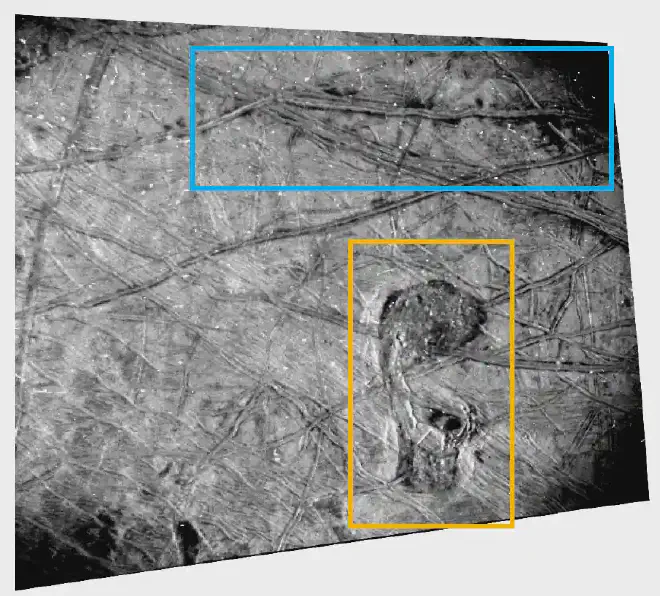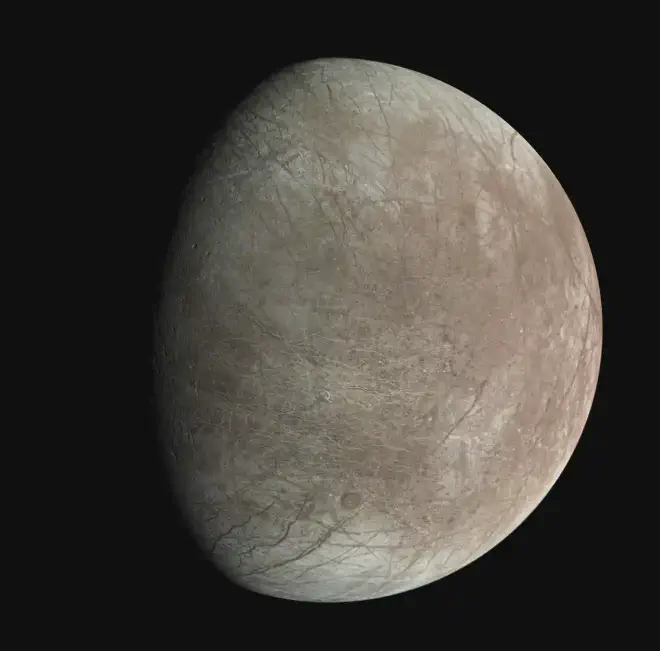
Images from Junocam camera aboard the NASA’s Juno probe, support the theory that the icy cap in the north and southern poles of Europe, the moon of Jupiter, is no longer where it used to be. Another high -resolution image of the Jovian Moon, taken by the Star Reference Unit (SRU) of the spaceship, reveals signs of possible activity of emerging and an area of breaking the ice layer through which the salt water could have recently emerged to the surface.
On September 29, 2022, Juno made its closest flyby to Europe, approaching 355 kilometers (220 miles) from the icy surface of the moon. The four images taken by Junocam and one by SRU are the first high-resolution images of Europe since the last approach made by the Galileo probe in 2000.
There is movement in frozen areas #
The surface monitoring of Juno from the surface of Europe allowed to obtain images near moon’s equator. When they saw the data, the Junocam team discovered that, together with the ice blocks, the walls, scarps, ridges and expected valleys, the camera also captured depressions of steep walls irregularly distributed from 20 to 50 kilometers wide. They resemble large ovoid pits found previously in images from other places in Europe.

The Platypus #
The image shows a region crossed by a network of fine furrows and sets of complicated double ridges (pairs of long parallel lines that indicate high characteristics in the ice). In the upper right corner there are dark spots possibly related to the activity of the cryovolcanic column (the fluid bubble under the ice).

Just below center and to the right is a surface feature that Juno science team members refer to as “The Platypus.” This surface disturbance (called “chaos” in planetary science) measures 67 kilometers (42 miles) from north to south and 37 kilometers (23 miles) from east to west. (The shape of this feature has previously been compared to a musical symbol.) The tiny white dots on the image are signatures of penetrating high-energy particles from the intense radiation around the moon.
The image was taken about 412 kilometers (250 miles) above the surface on Europa’s night side, in a region dimly illuminated by the glow of Jupiter. It is Juno’s highest-resolution image of the Jovian moon, measuring 840 to 1,115 feet per pixel (256 to 340 meters per pixel) and covering about 93 by 125 miles (150 by 200 kilometers) of Europa’s surface.
The Stellar Reference Unit (SRU) collects images of star fields to provide the positions of stars used to determine attitude. Designed for low-light conditions, the camera has proven to be a valuable scientific tool, discovering shallow lightning in Jupiter’s atmosphere, imaging the planet’s enigmatic ring system, and now providing a glimpse of Europa’s most fascinating geological formations.
Europa’s ocean #
A giant ocean is thought to reside beneath Europa’s icy exterior, and these surface features have been associated with ’true polar wander’ - a theory that Europa’s outer ice shell essentially floats and moves freely.

“True polar wander occurs if Europa’s icy shell decouples from its rocky interior, resulting in high levels of stress in the shell, leading to predictable fracture patterns. This is the first time these fracture patterns have been mapped in the Southern Hemisphere, suggesting that the true effect of polar wander on Europa’s surface geology is more extensive than previously identified,” said Candy Hansen, a Juno co-investigator who leads JunoCam planning at the Planetary Science Institute in Tucson, Arizona.
Gwern Crater… Which crater? #
JunoCam’s high-resolution images have also been used to reclassify a previously prominent surface feature on Europa’s map.
“Gwern Crater no longer exists,” Hansen said. “What was once thought to be a 13-mile-wide impact crater, one of Europa’s few documented impact craters, was revealed in JunoCam data to be Gwern itself, a set of intersecting ridges that created an oval shadow.”
The Platypus #
Characterized by chaotic terrain with mounds, prominent ridges, and dark reddish-brown material, Platypus is the youngest feature in its neighborhood. Its northern “torso” and southern “peak,” connected by a fractured “neck” formation, disrupt the surrounding terrain with lumpy matrix material containing numerous ice blocks 1 to 7 kilometers wide. The ridge formations collapse into the feature at Platypus’ edges.
For the Juno team, these formations support the idea that Europa’s ice shell may give way in places where there are pockets of salty ocean water lying beneath the surface.
About 50 kilometres north of the Platypus is a set of double ridges flanked by dark spots similar to features found elsewhere on Europa that scientists have hypothesized to be cryovolcanic geyser deposits.
“These features hint at current surface activity and the presence of underground liquid water on Europa. The SRU image provides a high-quality baseline for specific locations that NASA’s Europa Clipper mission and ESA’s Juice missions can target to look for signs of change and salty water,” said Heidi Becker, SRU co-principal investigator at NASA’s Jet Propulsion Laboratory in Southern California, which also manages the mission.
Europa Clipper is targeting the Jovian moon, including investigating whether the icy moon might have conditions suitable for life. It is scheduled to launch in the northern autumn of 2024 and arrive at Jupiter in 2030. Juice (Jupiter Icy Moons Explorer) was launched on 14 April 2023. The ESA mission will arrive at Jupiter in July 2031 to study many targets (Jupiter’s three large icy moons, as well as hot Io and other smaller moons, along with the planet’s atmosphere, magnetosphere and rings) with a particular focus on Ganymede.
Juno executed its 61st close flyby of Jupiter on May 12. Its 62nd flyby of the gas giant, scheduled for June 13, includes a flyby of Io at an altitude of about 29,300 kilometers (18,000 miles). Get ready for more news from the largest planet in our solar system.
Who, how, what #
JPL, a division of Caltech in Pasadena, California, manages the Juno mission for principal investigator Scott Bolton of the Southwest Research Institute in San Antonio. Juno is part of NASA’s New Frontiers Program, which is managed at NASA’s Marshall Space Flight Center in Huntsville, Alabama, under the agency’s Science Mission Directorate in Washington. The Italian Space Agency (ASI) funded the Jovian Infrared Auroral Mapper. Lockheed Martin Space in Denver built and operates the spacecraft.
JunoCam results recently appeared in Planetary Science Journal and SRU results appeared in JGR Planets.
Contact: notaspampeanas@gmail.com

